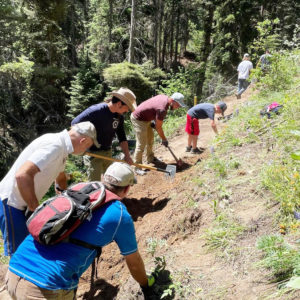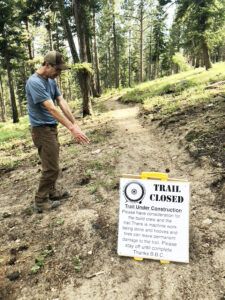
by Nathan Boddy
On a recent Tuesday evening, Jeff Kern, of Bitterroot Backcountry Cyclists (BBC), awaits a crew of volunteers to help shape and refine another section of mountain bike trail south of Lake Como. He gestures to a primary trail nearby, referring to it, offhandedly, as ‘Como Ridge Trail’ despite it being a labeled ‘Kern’s Turns’ on a popular Mountain biking app.
“I have a hard time calling it that,” he says with a grin. “I went on vacation for three weeks, and…”

Despite his discomfort with the trail’s name, Kern’s patience has certainly helped get things done. Kern is the Vice President of BBC, and his organization can be credited for years of patient work that is resulting in a wide variety of new mountain bike trails in the Lake Como area. Now in their third season of trail construction, the hard work of the BBC means that riders in the valley are starting to reap the benefit.
The BBC was formally organized in 2012 as a branch member of the IMBA (International Mountain Bike Association), and the focus of both groups is based upon advocacy for mountain biking, maintenance and creation of new trails, and the good health that riding can produce. Jeff Kern acknowledges that many of the existing trails within the Bitterroot are, “pretty rough, challenging and rocky,” but the BBC is also dedicated to making sure that the sport is accessible to new and beginning riders. To that end, the BBC has designed the Como Lake Trails to be enjoyable for first-timers as well as those seeking high adrenaline.
“What we have in mind are trails that are going to be attractive to riders of all levels,” says Kern. “This area is really front-country terrain that’s had a lot of logging activity over the years, and there are quite a few roads. There are some benefits to that, in that it creates a lot of access point to the trails so they’re easier to maintain. It also creates a lot of options for loops.”“This area is really front-country terrain that’s had a lot of logging activity over the years, and there are quite a few roads. There are some benefits to that, in that it creates a lot of access point to the trails so they’re easier to maintain. It also creates a lot of options for loops.”
Two Forest Service roads, 550 and 550A, both climb the Shannon Ridge south of Lake Como. As they twist and branch, they give access to both Little Rock Creek trailhead and the Tin Cup Overlook. Now, thanks to many hours of volunteer labor, the roads also intersect, at multiple points, with some of the newly constructed mountain bike trails. A rider could combine the network of existing roads with only some of the trails, or go ‘all in’ for more adventure.
“The trail system that we have in mind is kind of stacked loops,” says Kern. “Especially when it’s all built, it can be entirely single track.”
The mountain biking community of the Bitterroot Valley, so far, does not enjoy the same kind of access to trails that some other mountain communities do. Trails around Lost Trail Ski Area, Lost Horse Creek, and Calf Creek all offer a simple selection, but little compared to the scale of the Lake Como Trails. Once complete, the Lake Como Trails will be the largest collection of trails anywhere between Missoula, and Salmon, Idaho. That’s a strong draw, especially considering the rising popularity of the sport.
“Mountain biking is hands down the best sport for staying in shape, for being in the woods, for getting that feeling of flowing, and of motion, without getting hurt,” says 75-year-old BBC member, Jon Turk, who came to help work on the trails. “It’s just a crazy good sport.”
While the formal approval for construction of the trails came from the Forest Service three years ago, it was a grant from the federally funded and MTFWP managed, Recreational Trails Program (RTP), that helped kick the development into a higher gear.
“The first season was all hand built,” says Kern, adding that the RTP grant allowed the organization to hire Full Moon Trails of Darby to do a rough, machine cut before smoothing and shaping of the trails is undertaken by BBC volunteers. The layout of the trails, however, is carefully considered by both BBC and the Forest Service prior to construction.
“We follow a lot of rules and guidelines to design a sustainable trail. It’s all about where the water flows and making sure it’s not going to erode over time.” Kern notes that the trails are specifically optimized for mountain biking, but that the trails are open to all non-motorized users. Nonetheless, the BBC has its eye on that moment when the wheels can roll. “It’s also about, in our case, making a great mountain bike trail.”